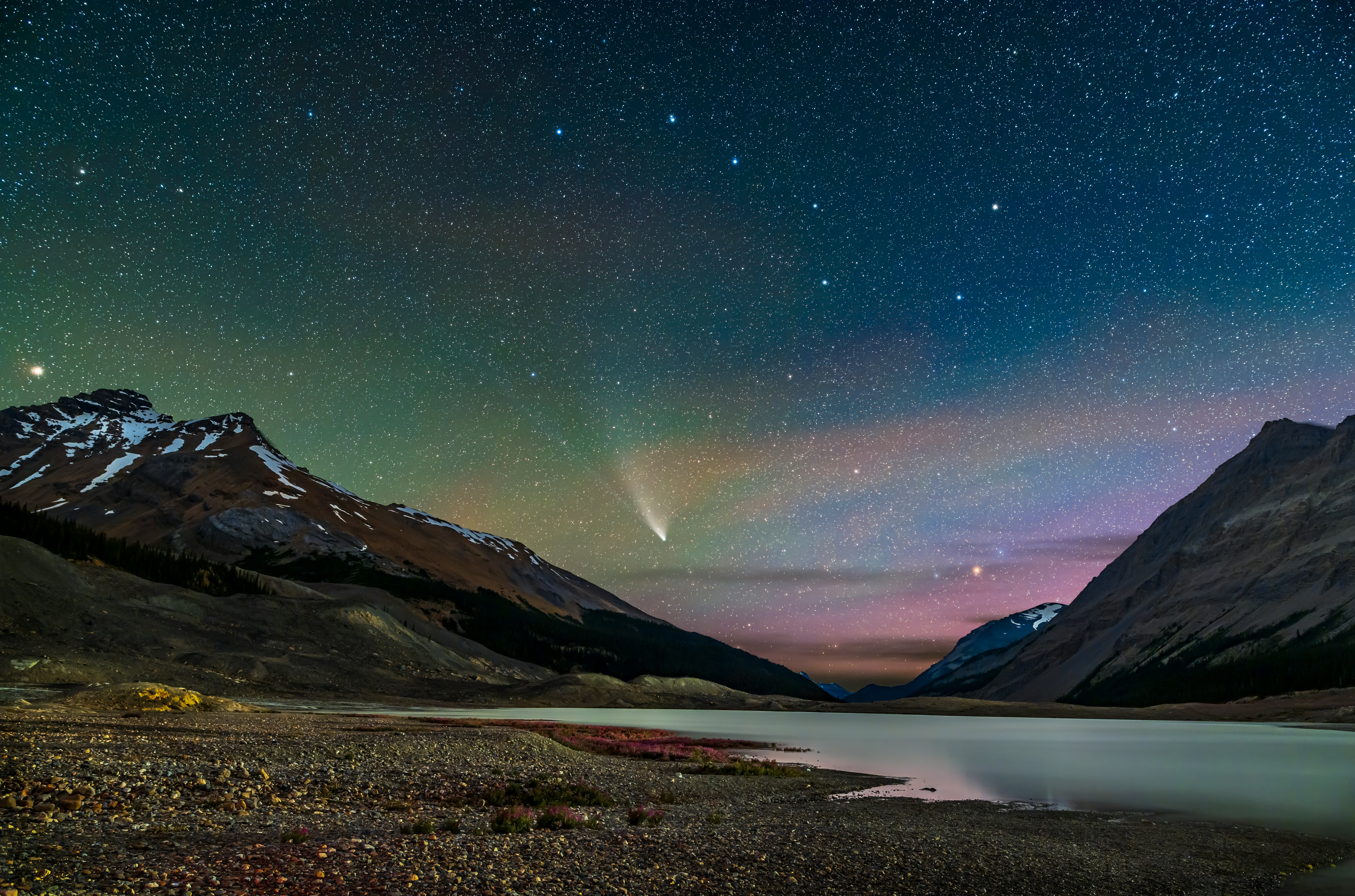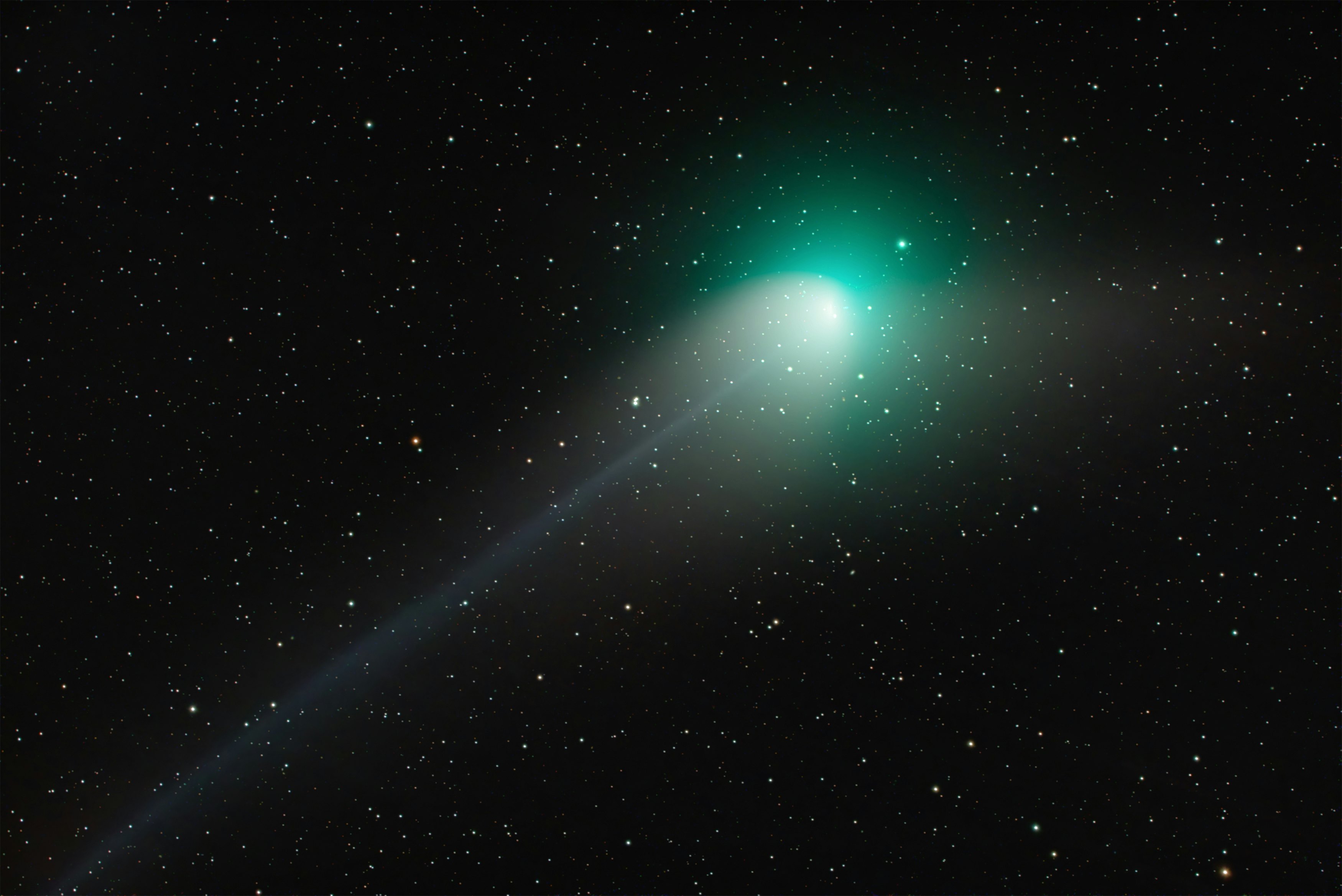
We’re a few days into January, but it’s not too late to tack on one last New Year’s resolution — look skyward. We’re all sitting on a giant, spinning sphere of rock, zooming around a huge ball of burning hydrogen, and so every once in a while, it’s worth glimpsing incredibly celestial events as they cross our infinitesimally small path compared to the incredible vastness of space.
If you’re looking for a chance to experience the awesomeness of the cosmos, 2024 is one of the best stargazing years in recent memory. The year’s showstopper arrives on April 8 when a total solar eclipse cuts across North America, but you can also look forward to comet flybys, meteor showers, and even a lunar eclipse.
Here’s everything our small corner of the universe has to offer in 2024.

Grab Your Binoculars and Spy on a Comet
When: ~January 25
Throughout January and early February, grab a good set of binoculars or a telescope (this one won’t quite be visible with the unaided eye) and scan the skies for 144P Kushida. This comet swoops around the Sun once every 7.4 years, swinging way out past Jupiter’s orbit before diving inward to a point between Earth and Mars. It’s not nearly close enough to be a threat, but its relative proximity means you can catch a pretty good glimpse as our planet and the comet briefly pass each other.
The comet will be at its brightest on January 25, but unfortunately, that night is also a full Moon and our satellite’s light will probably swamp the comet’s fainter glow. To get the best look, try scanning the skies a few days earlier or later to catch the comet near peak brightness but without the Moon’s photobomb. To find it, just locate the constellation Pleiades in the night sky, then look due south.
See the Sun’s Vanishing Act
When: April 8
On April 8, parts of North America will be plunged into sudden darkness as the Moon passes between Earth and the Sun, briefly blocking our star’s light and creating a few minutes of eerie artificial twilight known as a total solar eclipse. Check with NASA to see whether you’re in the path of the eclipse, and if you’re not, you can always catch a NASA livestream or plan a road trip. But wherever you happen to watch the 2024 solar eclipse, make sure you do it safely.
Over the next few months, Inverse will give you the lowdown or everything you need to know to plan your eclipse-watching, as well as understanding the science behind this amazing stellar display.
Earth Takes a Bite Out of the Moon
When: September 17
The Great North American Eclipse isn’t the only interesting celestial alignment occurring in 2024. On the night of September 17, people in most parts of the world can glimpse a partial lunar eclipse. Because the Sun is on the far side of Earth from the Moon, our planet casts a dark, round shadow over the lunar surface. Unlike total eclipses, this partial eclipse will look like something took a huge bite out of the Moon.
For stargazers in the U.S., the eclipse will start at about 8:40 p.m. ET, and the Earth's shadow on the Moon will reach its peak at about 10:45 p.m. While you can glimpse this event from your backyard, for the most dramatic effect, find as dark a place as possible. Although nothing quite...eclipses...a total solar eclipse, you thankfully don’t need special glasses to view this nighttime wonder.

Another Close Encounter of the Comet Kind
When: October 12
In mid-October, Earth gets another comet flyby, this time from recently discovered Tsuchinshan-ATLAS. Astronomers first spotted the comet in fall 2023, so we don’t know enough about it yet to predict exactly how bright it will get or whether it will sprout a long tail as it gets closer to the Sun. That depends on how many trips through the inner Solar System the comet has made before, how much gas or ice it contains, and several other factors. So, while the details of this flyby are a bit of a mystery, the odds of a comet visible to the unaided eye are worth the excitement.
Based on astronomers’ observations of its orbit, Tsuchinshan-ATLAS seems to make a huge loop around the Sun once every 80,000 years. Like the green comet C/2022 E3, which visited Earth in January 2023, this spacefaring object hasn’t been seen since the heyday of the Neanderthals (who were sadly ill-equipped to study it at the time).
For best viewing, look low in the eastern just before dawn in late September. After disappearing briefly as it passes close to the Sun, the comet should be visible again in mid-October only this time higher in the evening sky.
Annual Meteor Showers Aplenty
Meteor showers happen every year, but they’re always an amazing sight to behold. Here’s this year’s familiar-yet-incredible lineup:
- Lyrid Meteor Shower: The best night to watch is April 21-22, but viewing should be decent for a couple of nights on either side of the shower’s peak.
- Perseid Meteor Shower: The best night to watch is August 12-13. While the Perseids are technically visible from mid-July to late August, your chances are better closer to the shower’s peak.
- Orionid Meteor Shower: The best night to watch is October 20-21, but you have a good chance to spot a meteor or two throughout the whole month of October.
- Geminid Meteor Shower: The best night to watch is December 13-14, but viewing should be decent for the whole week around the shower’s peak.
In general, meteor showers are best viewed from the darkest vantage point you can (safely and legally) find. Get away from city lights, and be sure to turn off headlights, flashlights, and phone screens. Give your eyes about half an hour to adjust to the darkness, then lie on your back and look upward to take in the whole sky.
After that, sit back, practice patience, and take in a spectacular show — free of charge.







